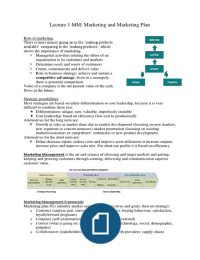Lecture 1 MM: Marketing and Marketing Plan
Role of marketing
There is more money going on in the ‘making products
available’ comparing to the ‘making products’, which
shows the importance of marketing.
> Managerial activities relating the offers of an
organization to its customers and markets
> Determine needs and wants of customers
> Create, communicate and deliver value
> Role in business strategy: achieve and sustain a
competitive advantage. Even in a monopoly
there is potential competition.
Value of a company is the net present value of the cash
flows in the future.
Strategic possibilities
Most strategies are based on either differentiation or cost leadership, because it is very
difficult to combine these two.
Differentiation: unique, rare, valuable, imperfectly imitable
Cost leadership: based on efficiency (low cost to produce/sell)
Alternatives for the long term are:
¤ Growth in sales or market share due to market development (focusing on new markets,
new segments or convert nonusers) market penetration (focusing on existing
markets/customers or competitors’ customers) or new product development.
Alternatives for the short term are:
¤ Either decrease inputs, reduce costs and improve asset utilization or increase outputs,
increase price and improve sales mix. For short-run profits it is based on efficiency.
Marketing Management is the art and science of choosing and target markets and getting,
keeping and growing customers through creating, delivering and communication superior
customer value.
Marketing Management Framework:
Marketing plan 5Cs (identify market opportunities, objectives and goals; then set strategy)
o Customer (analyse past, current, potential customers, buying behaviour, satisfaction,
loyalty/reward programs)
o Company (self-examination; SWOT => internal and external)
o Context (what is going on: economy, politics, laws, technology, social, demographic,
attitudes)
o Collaborators (stakeholders; analyze relationship with providers; supply chain)
, o Competitors (analyse the business sector, entering/leaving changes, who are the major
competitors, what are the competitors’ strengths)
↓
STP (set strategy: segmenting => targeting => positioning => acquisition retention)
- Segmenting (segment the market and develop profiles of segments)
- Targeting (evaluate segment attractiveness (the ‘match’) and select target segments)
- Positioning (develop positioning concepts for each target segment and select, develop
and communicate the chosen concept; so create concepts/ideas in the mind of the
customer)
↓
4Ps (how are you going to get there)
» Product
» Price
» Place
» Promotion
Marketing plan
1) Define the current business situation
(environment)
2) Define problems/opportunities facing
the business (SWOT)
3) Evaluate firms’ resources and
capabilities
4) Establish measureable and realistic
objectives (whit a timeframe, must be
measurable)
5) Define the strategies and programs necessary to achieve the objectives
Marketing plan is a guideline for the business centre’s marketing programs and allocations
over the planning period. And it summarized what the marketer has learned about the
marketplace and indicates how the firm plans to reach its marketing objectives.
, Lecture 2 MM: Market Segmentation and Cluster Analysis
There are a few basic market preference patterns:
Homogeneous preferences
Diffused preferences (heterogeneous)
Clustered preferences (with little difference within a cluster and much difference
between clusters)
Market segmentation is the classification of a market into distinct subsets of customers with
similar needs, wants, preferences. A more formal definition:
Market segmentation involves viewing a heterogeneous market as a number of smaller
markets, in response to differing preferences of consumers looking for more precise
satisfaction of their varying wants and needs.
Purposes of market segmentation:
> Consumers have different characteristics and firms cannot serve all segments
efficiently or with the same offer.
> Identify and classify segments according to the similarity of their members; members
within a segment are more or less similar, but they are different from members in
other segments.
> Helps to identify segments with similar characteristics that are likely to respond in the
same way.
> Firms need to focus on one segment or they have to develop different product lines.
Benefits of segmentation
The firm benefits due to the identification of valuable customers so the firm can target their
promotions and communication to the right group of customers (a goal of segmentation is
tactical targeting). In this way, they can higher customer lifetime value (they maximize
consumer value) and this causes a sustainable profit growth (as a reward).
The customer also benefits of segmentation, because he can fulfill his needs by customized
products and services and therefore get a personalized experience. This causes increased
customer satisfaction and in the end customer loyalty and retention.
Variables used as a mean to classify our customers (segmentation).
There are three main categories:
Descriptors: “who” is the customer (demographic, socio-economic, cultural). In a
business to consumer (B2C) environment descriptors are for example age, income and
education. In a business to business (B2B) environment possible descriptors are
industry, size, location and structure of organization. Descriptors can usually be
measured directly (observable).
Bases: “why” are these people actually buying our products, are quite psychological
constructs (needs, preferences, values and attitudes, lifestyles (VAL), personality).
Bases are usually not observed directly, it are latent variables. Bases can be measured
with a scale and you try to infer them with for example factor analysis.
Behaviours: “what” people actually do (usage, loyalty, responsiveness to marketing
mix). Behaviours are usually observable and can be measured directly.
There are effective descriptors (which have a remarkable effect between means, a variable
that is allowing us to classify clearly/properly the effect) and ineffective descriptors (which
have an ignorable effect between means).





